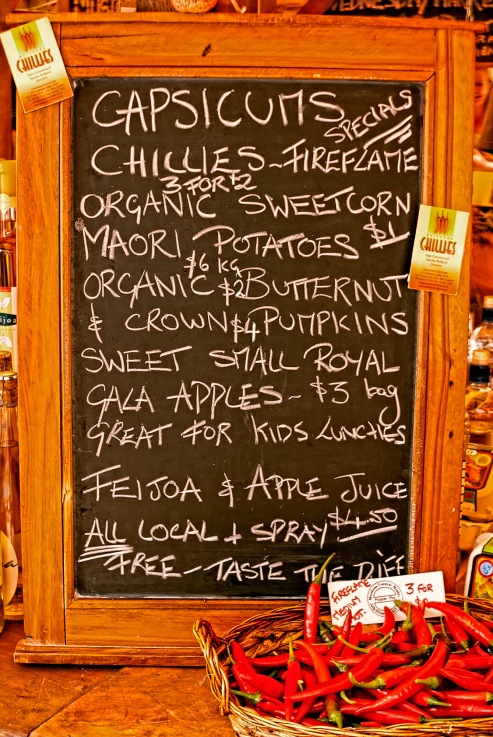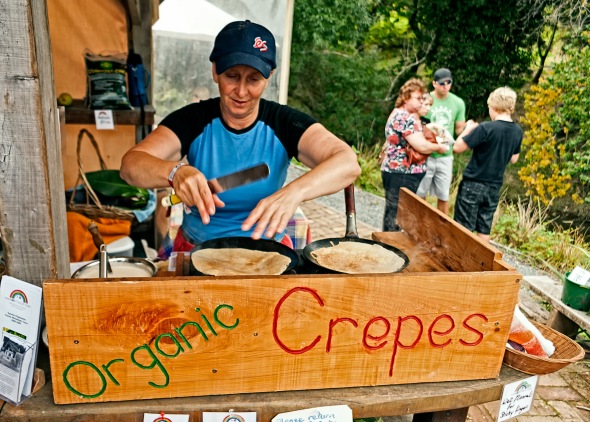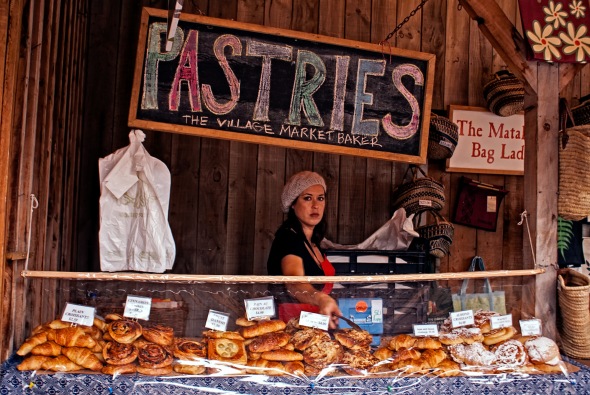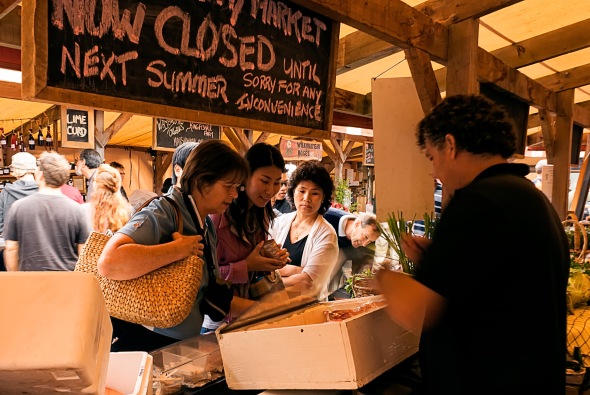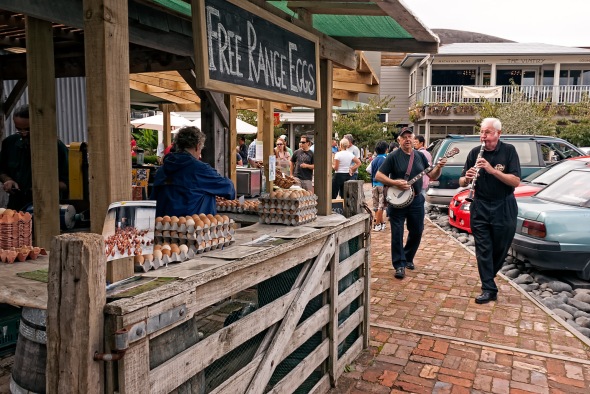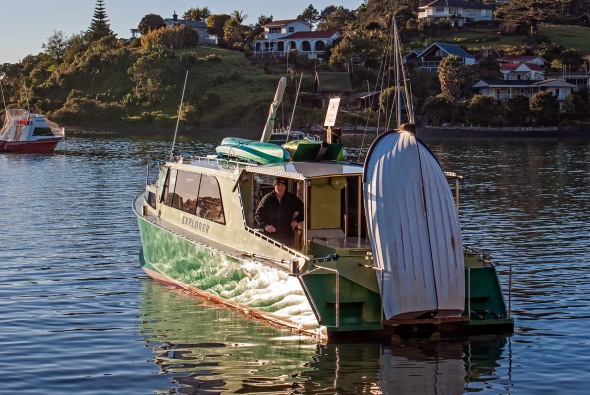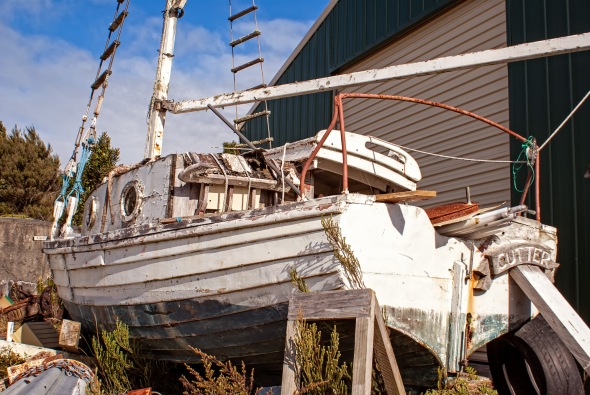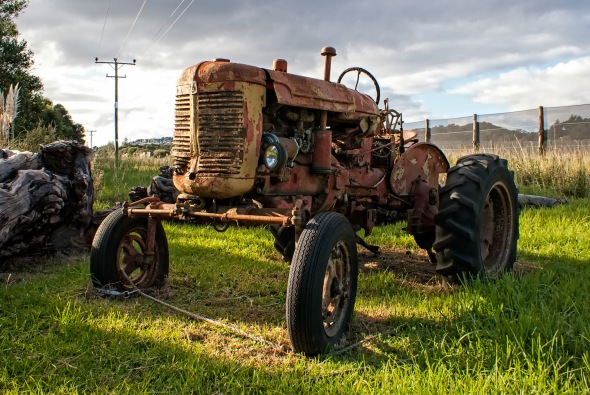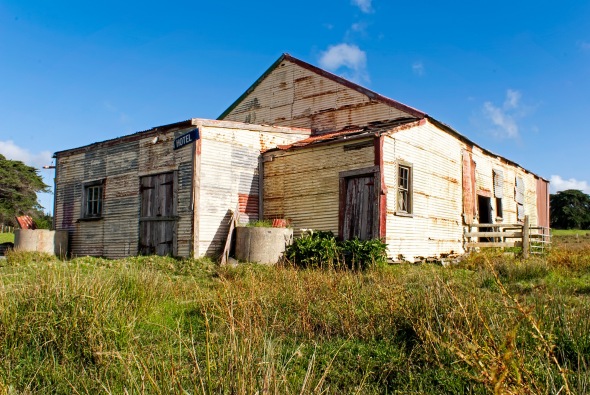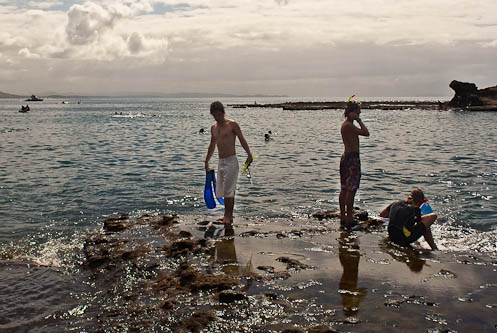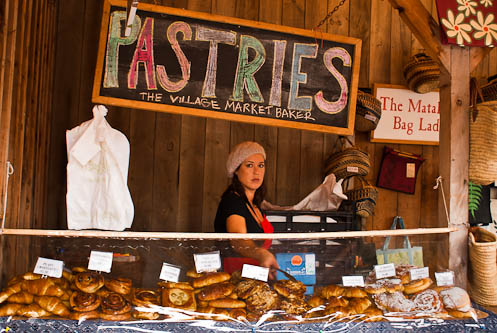Fireflame Chillies
I love street markets, no matter where in the world they are. Its the combinations of colors, activity and people that make them so fascinating. Here is a selection of images taken at the Matakana Market, a farmers’ market held during the summer at Matakana Village, an hour’s drive north of Auckland.
Now Closed … Sorry for any inconvenience
Well, that’s what the sign said! Clearly this wasn’t the case on the day of our visit to the Matakana Market. Perhaps the sign had been turned around?
How about some organic beans, or spray-free tomatoes? This is a farmers’ market afterall, and we have t cater for all tastes.
Baby Royal Gala apples as well, you know, the ones on the bike! Or is the man on the bike chasing the apple? But, I’ll take some special capsicums, please. And is that pumpkin $4, or is it Number 84?
Market Minstrels
Because I haven’t had much time lately to get out and photograph anything, because of packing our house full of belongings into a storage unit, so I have revisited my library of images to get inspiration for posts. The next few posts will contain images taken at the Matakana Market located about an hour’s drive north of Auckland. The farmers’ market runs on Saturdays through the summer months and attracts large numbers of visitors from Auckland and the surrounding district, especially from the holiday homes at the nearby beaches.
One of the features of the market is the small group of musicians who play there during the opening hours to entertain shoppers. Occasionally they leave their “stand” and wander through the market. Here are a couple of images of the market minstrels.
Explorer – Definitely not a do-up!
On the opposite coast and further north than Dargaville, that featured yesterday’s post, is the Manganui Harbour (or Harbor if you live in North America). On my morning walk on the day after finding the “do-up” at the Dargaville Museum I saw this beautiful craft being readied for the day’s voyage.
The launch “Explorer” was immaculate, and the owner clearly very proud of his vessel. It had lovely classic lines and was painted in appropriate colors to match the style. For me it was love at first sight! The other more modern and “flasher” designs in the harbor didn’t stand a chance. This was a vessel to be loved and cherished. It took all my efforts to drag myself away from admiring this thing of beauty. I have no desire to own such a craft, but given half a chance I would leap at an opportunity to go aboard and take a cruise. So much for dreaming. It was nice while it lasted!
Do-up Job
Behind the pioneer museum in the Northland town of Dargaville is a yard that contains a number of projects awaiting attention.
The Dargaville Museum has exhibits that tell of how the district has developed through the years, from a 16 metre long pre-European Maori canoe through to the newly built replica gumdiggers camp, from shipwreck relics recovered from the coast to the masts of the ill-fated Greenpeace protest ship Rainbow Warrior. It makes for an interesting visit to get a flavor of the Northland district before venturing further north.
The “exhibit” that caught my attention though was the old working boat “Cutter”, clearly in need of a bit of TLC (tender loving care). She looked quite forlorn sitting in the back lot among miscellaneous other discarded items. For all that, she still had a worn dignity that comes from years of honest hard work.
Puheke
The Karikari Peninsula is at the northern end of Doubtless Bay in the Northland region of New Zealand. Doubtless Bay was named by Captain James Cook who said, apparently, “Doubtless a bay” in 1769. It’s a large sweeping bay with a 14 km white sandy beach, a holiday makers’ and anglers’ paradise. The beach ends where the Karikari Peninsula begins.
Almost directly opposite and on the northern coast of the peninsula is a pimple of a mountain named Puheke. Because the surrounding area is flat, this tiny mountain takes some prominence in the landscape. The short climb to the top produces wonderful views of the surrounding area, including that of another sweeping white beach bordering Rangaunu Bay to the northwest. Appropriately, this is named Puheke Beach.
Close to the foot of Puheke is is the small reedy Lake Rotokawau.
For years the Karikari Peninsula has been a favorite holiday spot for many New Zealand families who seek both beauty and solitude, with plenty of fishing, of course! During the 1950s and 60s many of the holiday “homes” were mere cottages, often unlined and without electricity, a connected water supply, or formal sewage system. Tank water sometimes ran out in long hot summers and a new toilet pit had to be dug every few years, necessitating a moving of the “little house” to a new location. That’s how it was when we first holidayed in “The Far North” in the early years of our married life. In more recent years the holiday home have acquired a few more comforts, along with electricity.
Old Work Horses
Well, not the kind you were likely thinking of perhaps. Outside the entrance to Gumdiggers’ Park, just north of Northland’s northern-most town Awanui, are two old mechanized work horses – a tractor and a truck. Gumdiggers’ Park is a small museum and outdoor display dedicated to the digging of Kauri gum.
Kauri gum is formed when resin from Kauri trees leaks out through fractures or cracks in the bark, hardening with the exposure to air. Lumps commonly fall to the ground and become covered with soil and forest litter, eventually fossilizing. Prior to European settlement the indigenous Maori used the amber-colored gum for chewing, fire lighting, jewelry, and as the basis for a pigment used in tattooing. European settlers soon found that the gum mixed easily with linseed oil to make an excellent varnish, and from 1910 Kauri gum was used extensively in the manufacture of linoleum. A lucrative trade started in the 1890s and continued until the 1930s when synthetic substitutes came into use. In the late nineteenth and early twentieth centuries transient workers fossicked in areas where old Kauri forests once stood, often in swampy ground, seeking out hidden gum deposits which they sold at quite low prices to gum merchants. My own grandfather worked in the gum fields of Northland when he first landed in New Zealand in the first decade of the twentieth century.
Getting back to the mechanized work horses. Although they are outside Gumdiggers’ Park, they are unlikely to have been used in the gum digging industry described above. Because of their age, they are more likely to have been used in the recovery of “Swamp Kauri” i.e. old fallen logs which are hauled out of the swamps where they had been preserved by swamp water for use in furniture manufacture and souvenirs of Northland.
For me, these two vehicles were as interesting as the exhibits inside the park, especially because of the late afternoon lighting.
“King Bill’s” Hall
Just south of Rarawa Beach is the small settlement of Houhora. When I first visited Houhora in my youth I was able to visit the Wagener Museum, which housed an eclectic collection of artifacts relating to the early settlement of the district in an old stables building. Sadly the museum burned down In the 1980s and some of the collection was lost. The remainder of the museum closed in 2003, but a down-sized version has since reopened. The old museum was a great place to visit and was known to many Kiwis of my age (that’s telling you a bit!).
Not far from the old museum, and next to the Houhora Pub, are several old buildings that have fallen into disrepair but have a strong local historical interest.
One of them is the old hall which was owned by “King Bill”. “King Bill” Evans was a trader, publican, land owner and general entrepreneur in the 1890s. The local hall was a centre of activity in those days and was variously used for meetings, dances, weddings and church services. Today it is slowly rusting away in the field near the pub.
These images were taken in the late afternoon as the sun was sinking towards the horizon in the west. Click on images for a larger view.
Rarawa
There has been a bit of a lull lately. After 32 years living in our present house we are now packing our lives into boxes as part of the moving on process. Consequently, there hasn’t been a lot of time for making new posts. So here is something to keep the flow going.
Several years ago we took a short break with some friends in the far north of the North Island of New Zealand. The Northland region is all that area north of and including the City of Whangarei. Apart from Whangarei and a couple of other small regional centres, Northland is sparsely populated. Industries in the region are mainly farming, forestry , fishing and tourism. It also has some wonderful beaches that attract campers in the summer holidays, but are left in solitude for the rest of the year.
Rarawa Beach is one.
Rarawa Beach is a 55 km drive north of the second largest Northland town, Kaitaia. The white sandy beach is about 2 km in length between rocky headlands at either end. A small stream cuts a meandering path across the beach to the surf . It’s not hard to find that you have the beach all to yourself.
And that’s how we found it on the day of our visit. Just an idyllic place to be. Click on images for a larger view.
Whangarei Heads, Northland, New Zealand
If one follows the road east from the Town Basin in New Zealand’s northern-most city of Whangarei the journey will take you past the remnants of a volcanic cone, beautiful beaches and rural pastureland and end at an ocean beach at the northern head of the Whangarei Harbour.
The volcanic landscape includes Mt Manaia, Mt Lion and Bream Head which are the scattered remnants of a large, 50 kilometer diameter volcano that erupted with force 20 million years ago during. Its jagged outline is similar to that of other volcanic outcrops in Northland that erupted at about the same time.
These images were taken late afternoon on a glorious spring day last weekend.
- Mt Manaia, Whangarei Heads, Northland, New Zealand
- Urquarts Beach, Whangarei Heads, Northland, New Zealand
- Urquarts Beach, Whangarei Heads, Northland, New Zealand
- Urquarts Beach, Whangarei Heads, Northland, New Zealand
- Ocean Beach, Whangarei Heads, Northland, New Zealand
- Ocean Beach, Whangarei Heads, Northland, New Zealand
- Sunset Fishing, McKenzie Bay, Whangarei Heads, Northland, New Zealand
- McKenzie Bay, Whangarei Heads, Northland, New Zealand
Autumn/Fall Colours Revisited
I have been sifting through pictures I have taken over the last year and reflecting on what I have learned, particularly with composition and processing. This image was taken last year at Morris & James Pottery in Matakana, Northland.
I knew what I was trying to capture when I took the photograph, but when I first saw the image on the computer screen I was disappointed. There was too much in the photo and the vibrancy of the colours shown in the window frame, pots and tree were flat and uninteresting. I passed over the picture and went on to another.
Today I have revisited a number of images I took that day and had another close look at them. This image was cropped from a larger picture that was cluttered with extraneous intrusions from three sides which made it a “nothing” shot. Upon revisiting the photograph with the benefit of time having elapsed I was able to see what it was that I had originally wanted to capture. Here is the result.
Potter’s Room
Matakana Village has become an arts and crafts centre on the Marhurangi Peninsula in Northland. Surrounded by farmland and a growing number of vineyards,it has become increasingly popular with holiday makers and weekenders from Auckland. In the basement area of the old Matakana Co-operative Dairy Factory there is a potter’s workshop. Light from the windows picks up the warm colours of newly thrown and drying pots waiting to glazed and fired. The ambiance of old timbers of the dairy factory, dust particles hanging in the air, and the aging concrete floor add atmosphere to the scene.
Sony Alpha DSLR – A200, 1/2000 sec, F 5.6, ISO 400, Sony DT 18-70 mm lens at 24 mm
Goat Island Marine Reserve
Near Cape Rodney on the Mahurangi Peninsula in Northland is the Goat Island Marine Reserve. Throughout the year crowds of visitors are drawn to the area to snorkel and dive around the reef between The University of Auckland Marine Research Centre and nearby Goat Island. Those unable to swim can enjoy seeing fish swim around their legs as they paddle knee-deep on the nearby beach or from the reef itself.
This group of young people were taking a rest while others enjoy swimming with the fish between the reef and the island.
Sony Alpha DSLR – A200, 1/2000 sec, F 5.6, ISO 400, Sony DT 18-70 mm lens at 24 mm
The Village Market Baker
A 60 km drive north of Auckland will take you to the delightful rural village of Matakana. The village lies on the road from Warkworth to the fishing village of Leigh and the Leigh Marine Reserve. In former times the village was no more than a dairy factory, general store, pub, a small church and a the local country primary school.
Over the last 30 years that has all changed. City folk discovered the nearby beaches and built holiday cottages that drew weekend and holiday travellers into the area. With them came the desire for some of the facilities they were used to in the suburbs so craft shops, cafes and coffee houses began opening in the village. The Dairy factory has been taken over by a potter, craft furniture maker and a gift shop. Nearby a boutique cinema and shopping area has opened. In the area between, behind the shopping area, a farmers market is held each Saturday morning throughout the year.
I captured this image while walking through the market. Just before the shutter “clicked” the girl looked up slightly startled, then smiled and carried on with her work.
Sony Alpha DSLR – A200, 1/20 sec, F 4.5, ISO 100, Sony DT 18-70 mm lens at 26 mm

